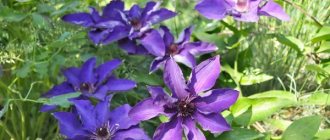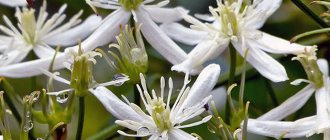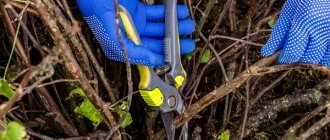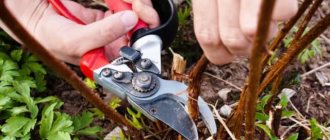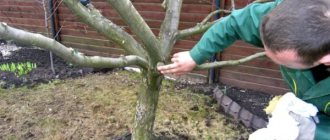Astilbe is a beautiful perennial herbaceous plant that invariably delights with the openwork charm of its fluffy fir-tree inflorescences and lacy leaves. Under natural conditions, the queen of the shady garden is found in mountainous regions where the climate is monsoon, even at an altitude of almost 5000 meters. Therefore, this perennial is very hardy and quite frost-resistant, and it will be quite comfortable in various regions of our country where winters are quite cold.
How to properly care for this perennial in the fall, what should you do to prepare it for winter? All this will be discussed below.
Features of caring for astilbe in autumn and in preparation for winter
As you already understand, this perennial is distinguished by its hardiness and good resistance to frost, so there is a temptation to do nothing at all in the fall. So what activities should still be carried out in the autumn months in order to properly prepare astilbe for the cold season?
This flowering plant especially needs care in the first year after planting . In order for a young bush to get stronger and survive the winter well, you should not let its buds bloom in the first season. Therefore, peduncles should be removed immediately, even before inflorescences form on them. In this case, all the nutrients will be used for active growth of the root system.
The soil around young astilbe should be regularly watered and loosened so that more oxygen reaches the roots (there is better air exchange). At the same time, do not forget to remove weeds that prevent young plants from developing. When the bush grows, it will crowd out all the weeds, and there will be no need to fight them.
By the way! About how to properly plant and care for astilbe. Read more in this article .
Plants that are more than 5 years old are especially sensitive to autumn care - their rhizomes grow strongly (including upwards) and become more sensitive to cold if there is little (or no) snow in winter. In this case, you just need to not only mulch the tree trunk circle, but also cover the plant with non-woven material (lutrasil, spunbond) or spruce branches so that the root system is not damaged by severe frosts.
Important! In the fall, you can also propagate and replant astilbe by dividing the bush. This is especially true for bushes older than 5 years.
Thus, in the fall, caring for this perennial comes down to the following procedures:
- feeding;
- pruning flower stalks and dried stems;
- mulching the soil around the plant - shelter for the winter.
Each of these procedures should be discussed in more detail so that amateur gardeners who want to grow this flower on their site can admire its active flowering every year.
Autumn feeding
In the autumn (after flowering), you should definitely take care of applying fertilizer to each astilbe bush.
Important! You should know that organic fertilizers applied in the autumn will completely decompose only in spring. Therefore, all the nutrients obtained during their decomposition will reach the plant only when it begins to grow in the spring.
To feed astilbe in the fall (after flowering), fertilizer containing potassium and phosphorus is applied. These minerals allow the root system to restore its strength after abundant flowering and prepare for the coming frost. No more than 1-2 tbsp should be applied to each bush. spoons of such complex fertilizer (30-40 grams of each per 1 square meter of bed). In order for the fertilizer to penetrate to the roots faster, in the fall it is better to do it not in dry form, but in liquid form (dissolve in 10 liters of water). If the fertilizer is applied dry, then the bushes should be watered generously.
When it fades
Many novice gardeners believe that with the arrival of autumn there is virtually no need for garden care, especially for perennial flowers. Astilbe is an unpretentious species of perennials, which is why it is often completely neglected during the autumn months. It is enough to trim the stems, some believe, but there are those who are too lazy to even trim the stems. What kind of care is there?! But in vain.
After this flower blooms, you should not immediately cut off the panicles; you can grow seeds from them. But even this is not what makes gardeners hesitate to trim off drying panicles. The fact is that even semi-dry inflorescences of the plant will decorate the flower garden and garden for a long time until the end of the season. But when the time comes to put things in order in the garden and flower beds before the winter cold, the stems of the bushes must be cut to ground level, and the soil in the flower bed must be mulched, especially if the plant was planted by dividing the roots in spring or early autumn. Trimmings that do not contain seeds or are not needed for flower arrangements are usually burned, and the ash is scattered into the ground as fertilizer.
Dividing a bush in autumn
Why is this being done? The purpose of dividing the bush in early autumn is to rejuvenate the perennial. Over the winter, the roots of the shrub will become harder, almost woody, making it difficult to divide. At the beginning of autumn, the root is divided in such a way that a growth bud remains on each separated piece of root, then in the spring the planted astilbe will bloom profusely again. It is only necessary to mulch the area, and it is advisable to throw branches of spruce branches or straw on the planted roots so that the new plants are not afraid of winter frost. Then the young flower will not freeze and will not disappear after temperature changes. In general, this plant is frost-resistant, but newly divided roots can get sick. In addition, this flower sometimes has roots that grow upward. For this reason, they are exposed and can freeze if the winter turns out to be frosty and snowless.
If pruning or replanting was not carried out this fall, this can be done in the spring, and in the fall you can simply add fertilizer and finish the autumn care.
Why rejuvenation?
Many inexperienced gardeners often wonder why constantly rejuvenate a plant? The thing is that this perennial does not grow in one place for more than five years. Of course, you can leave it to grow on the old revenge for ten years. But if it is not replanted and rejuvenated, after five years the plant will begin to wither: the bush will no longer be so bright, there will be fewer flowers, and very little splendor. And the flowering period will be shortened. The bush will simply begin to fade little by little. And the longer the wilting process, the harder it is to rejuvenate the plant later. But you don’t have to replant the bush, but simply divide the root and feed the soil.
What else needs to be done in the fall?
- In the fall, carry out a second feeding of the soil around the plant. By this time, even the last random flowers on the plant will have faded and the seeds will have ripened. In the fall, fertilize with phosphorus and potassium liquid fertilizers so that the stems do not burn in the spring. After this, it is necessary to loosen the soil and mulch.
- Between the bushes, the soil should be sprinkled with peat or sawdust. You can sprinkle it with soil or pine needles. This action will guarantee that the perennial will survive even in the most severe frosts.
- The stems need to be trimmed after fertilizing, before the first frosts and snow fall on the ground. An interesting fact is that after all the stems are cut, young leaves appear in place of the cuts. In winter they are still visible under the snow, but in spring these leaves die off and new shoots grow in their place.
Cut panicles can be saved with seeds to be used for propagation later if desired. But in general, panicles can be used in winter flower arrangements and vase arrangements.
Is pruning necessary?
Some gardeners do not prune the perennial after flowering. They believe that dry stems do not need to be pruned because they trap snow in the garden, and this not only provides additional moisture. Snow is also a thermal cushion that protects the roots of the plant from freezing. But most gardeners agree that pruning the plant is healthier for the plant. And you can save snow in the garden in other ways. They are described above. After all, if the winter is snowless, the roots of the perennial may freeze without shelter, and it will be difficult to cover the plant, the same uncut stems will interfere.
Pruning astilbe in autumn
There are many varieties of this perennial, and they bloom at different times (from June to September).
Advice! It is not at all necessary to immediately remove faded panicles at the end of astilbe flowering; they look very attractive even when dry, which means they can make your autumn garden even more colorful.
Before pruning, you should prepare the necessary equipment for this procedure. Typically, trimming the stems is done with garden pruning shears. In order not to expose the bushes to possible infection, before starting the procedure, the instrument is placed for half an hour in a pink solution of potassium permanganate.
Why prune astilbe in the fall?
It is advisable to have time to trim the flower stalks before the plant sets seeds, since such a procedure is often useless (unless, of course, you want to collect seeds and propagate in this way), and the plant will waste its energy on it.
Another opinion! Some gardeners, on the contrary, think that the dry inflorescences of faded astilbe spoil the aesthetic appearance of the garden. It is much better if the bush is still green without dry panicles.
Therefore, most often, after flowering, astilbe is not cut off completely, but only those flower stalks that have finished flowering are removed.
A little later, after the first frost, the rest of the above-ground part of the bush is also trimmed, because a trimmed perennial is easier to cover for the winter.
When is it better to prune astilbe - in autumn or spring?
As a rule, astilbe should be pruned in the fall: inflorescences - after flowering, and the remaining above-ground part of the bush - after frost. But, in principle, this can be done in the spring, if the plant does not require complex shelter.
Timing for pruning astilbe in autumn
The timing of plant pruning in autumn differs in different regions of the country depending on specific climatic conditions. The fact is that the above-ground part of astilbe is cut off after the first autumn frosts have passed (dried shoots and leaves will darken and droop from frost). In different regions of Russia, pruning is carried out from early October to mid-November.
Advice! If you don’t want to bother, then you can cut off the dry inflorescences along with the above-ground part (which will have already formed seed pods by this point), and not do this immediately after they bloom.
How to prune astilbe correctly in the fall
Sometimes novice flower growers prune this flower incorrectly - leaving stumps that are too high (10-15 centimeters). Stems sticking out from the stumps will look very unsightly, and covering them is not very convenient.
Therefore, all dried and drooping stems are cut off only at the root. Then, to protect them from frost, the bushes are hilled up with a layer of mulch. For this purpose, you can take high peat or rotted manure, humus. The thickness of the mulch layer should be from 5 to 10 cm.
Video: pruning astilbe in autumn
How to prune astilbe correctly
Astilbe fades in mid-summer, but the lush leaves continue to delight with their beauty until autumn. Therefore, after removing the flower stalks, there is no need for pruning; this is done only in late autumn, when the leaves have dried and the time has come to prepare the plant for the winter cold.
- It is convenient to cut the stems with ordinary pruning shears. Old shoots are removed completely, down to the same level with the ground, but very carefully to avoid damage to the young buds - they are located slightly above the astilbe rhizome.
- Pruning is repeated annually, in the fall at the same time, until the onset of severe cold. On average, the time to remove dried leaves is in October or November.
- After the procedure, you must loosen the soil and lay it in a mound around the bush. Particular attention is paid to young plants - first-year plants, and bushes older than 4 years - the rhizomes of such flowers are quite weak and vulnerable.
Advice. Pruning astilbe requires sterility. It is very important to keep the instrument clean and treat it with a disinfectant solution immediately before use. Slightly diluted potassium permanganate is well suited for this.
Disinfecting the blades will protect the plant from diseases and parasites. It is also important to ensure that the procedure is repeated before processing the next shrub.
Astilbe flowering
Astilbe shelter for the winter
If gardeners grow astilbe in the southern regions, then they do not need to cover it for the winter - winters there are warm, and even the root system of adult plants, growing towards the surface of the soil, will not freeze over the winter period. It's another matter if your climate is colder.
Is it necessary to cover astilbe for the winter?
In principle, the frost resistance of this perennial is quite high, so it does not freeze even at temperatures below -25 degrees. However, in this case, those roots that are too close to the surface of the soil may freeze, which means the buds may also freeze. As a result, next season the vegetative mass of astilbe will grow less actively, and flowering will be less abundant.
Therefore, covering perennial bushes for the winter is as important a procedure as autumn pruning.
How to properly cover astilbe for the winter
In the first years, it is enough to hill up the pruned bushes and cover them with a layer of mulch (peat, pine litter, compost are suitable). But older plants, which are more than 5 years old, need to be covered better, especially if there is too little snow in the regions in winter or the thaw period in winter is replaced by severe cold.
In this case, a square fence is built from boards or bricks around each bush. Then dry leaves are poured inside, and a layer of non-woven material (agrofibre, spunbond) is pulled on top, the edges of which should be pressed to the ground with stones or bricks so that a strong wind does not tear it off.
Tips and tricks for flower growers
Astilbe can be grown in rows, groups, including a variety of flower colors: purple, white, almost burgundy, pink and lilac. It is also advisable to combine it with other plants, especially those that bloom quickly. Low-growing varieties up to 25 cm are appropriate to plant on an alpine hill or border.
Question: Is it necessary to prune? There are gardeners who believe that dried stems retain snow, which creates a warm cushion, and the cover is also a source of moisture. The idea that this should help the plant is not without merit. But most gardeners consider pruning more useful, since in the absence of snow in winter the roots may freeze and it will no longer be possible to cover them.
vote
Article Rating
What are the features of preparing astilbe for winter in different regions?
There are some nuances in preparing this perennial for winter in different regions of our country.
In the middle zone (Moscow region)
In the middle zone (Moscow region), if the winter is expected to be snowy and not too cold, then it is enough to just mulch the pruned perennial. Additionally, you can cover it with spruce branches, straw or other non-woven material that allows air to pass through. In this case, the greenhouse effect will not appear under the shelter (there will be no damping off).
In the Volga region
In the Volga region, where winters are not too cold, this perennial can be covered for the winter, as in central Russia.
In the Urals and Siberia
In the Urals and Siberia, winters are colder, and the ground can freeze to a depth of 0.8-1.0 m, so astilbe should be covered not only with a layer of mulch, but also a frame should be made around it with the covering material always pulled on top.
Typical mistakes in caring for astilbe in the fall and in preparation for winter
Many beginners believe that astilbe tolerates the cold season well and does not need any measures in the fall. As a result, these flowers grow worse next season, and flowering may be weak.
The main mistakes that novice gardeners make during autumn care and preparing astilbe for winter:
- Fertilizers are not applied in the autumn;
- incorrectly pruned (or not pruned at all);
- do not mulch or cover for the winter.
Taking care of this perennial flower in the fall is important if the gardener wants to enjoy its blooms throughout each subsequent season. After all, in fact, there is nothing difficult about properly preparing astilbe for winter.
Care after pruning
Trimming the astilbe is not enough; the bush needs to be provided with comfortable conditions even after that. Then in the future it will bloom profusely and look attractive in the garden. Astilbe's homeland is mountainous, and this explains the fact that the plant tolerates winter cold well. But there are also snowless winters when the bush requires mandatory protection.
The root system of mature plants is insulated and fed in the pre-winter period. Additionally, gardeners mulch the soil to ensure lush flowering next season.
Mulching
Covering the soil around the bush with mulch helps protect the root system and young buds from freezing.
Cover the soil and the pruned bush with a layer of mulch of 15-20 cm. For mulching, flower growers use fine tree bark as a covering layer. This material also helps protect roots and buds from low temperatures.




